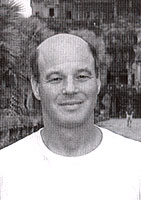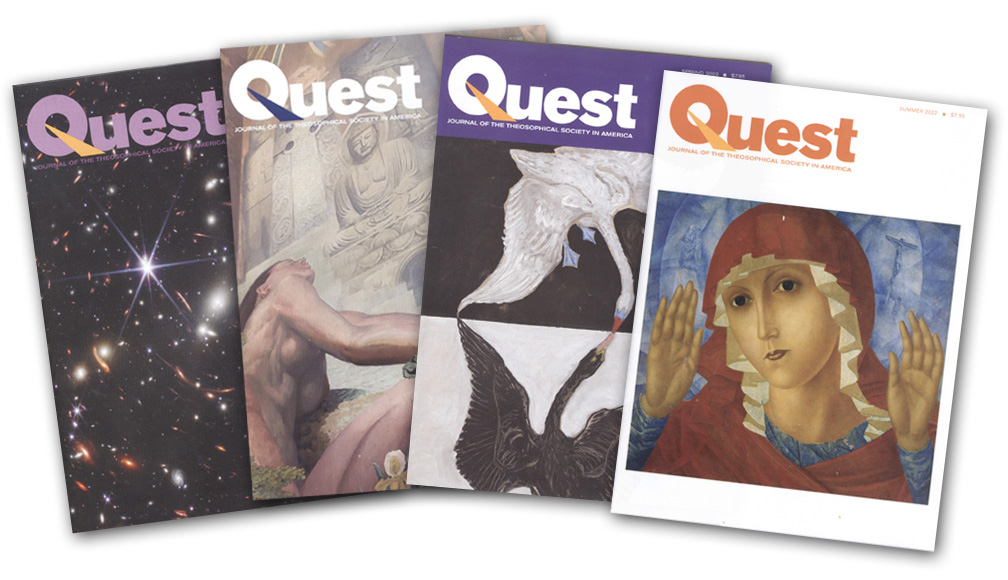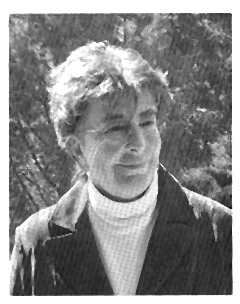Anne Frank and Uncle Willy
By Edward Tick
Originally printed in the July - August 2005 issue of Quest magazine.
Citation: Tick, Edward. "Anne Frank and Uncle Willy." Quest 93.4 (JULY-AUGUST 2005):130-135

Last year my wife Kate and I traveled to the Netherlands with our children Gabriel and Sappho. We made this trip in honor of our son, who was graduating high school and leaving home for art school. Kate and I wanted to give Gabe a rite of passage by taking him to see Vermeer, Rembrandt, Van Gogh, and the worlds that had produced them.
We arrived in Amsterdam on the Friday evening following Easter. While taking a respite in a quiet canal-side cafe, we realized we were near Anne Frank's house. A short stroll brought us to 265 Princengraft, a building snuggled into a residential section of Amsterdam that overlooked a picturesque canal. Though it was the evening of the Jewish Sabbath, to our surprise the museum was open. We felt grateful to be able to honor the Sabbath and begin our tour of Amsterdam in this manner.
Men, women, and children of various ethnic backgrounds walked in a heavy, attentive, prayerful silence through stark rooms still darkened by blackout shades. This was the place where Anne, her parents Otto and Edith, her sister Margot, Fritz Pfeffer, and the Van Pels family—Hermann, Auguste, and their son Peter—hid together from the Nazis for more than two years. Large pictures from the 1940s show daily life in Amsterdam and then in contrast, the life in the concentration camps under the Nazis. Excerpts from Ann's diary are displayed on the walls: "One day this terrible war will be over. The time will come when we will be people again, and not just Jews."
Visitors are taken back in time when entering the kitchen and common room where they had "to whisper, tread lightly during the day, otherwise the people in the warehouse [below] might hear us." Coming to the front office that served as a bathing area on Saturday afternoons Anne wrote that she and her sister "scrub ourselves in the dark, while the one who isn't in the bath looks out the window through a chink in the curtains." Finally there is the bedroom where the movie magazine cutouts still hang that Anne used in a desperate attempt to bring some glitter to her shadowy, shut-in existence. Similarly, the board game Peter received for his birthday lies where he and Ann used to play.
A visit to these rooms brings the Holocaust of World War II and the present-day global warfare against civilians up-close and personal. These rooms stage the brute reality in which the Frank family lived and the moral tragedy humanity has inherited, a tragedy in which goodness and innocence struggle to survive ultimate evil. We are all familiar with Anne's famous words, "In spite of all that has happened, I still believe that people are basically good at heart," and we gain strength from this brave twelve year-old girl. But there are aspects of this tragedy that are not popularly known.
In these lonely rooms Anne and her companions learned about the gas chambers. She wrote, "The English radio says they're being gassed. I feel terribly upset." And at the end of the Annex tour, a video reports Anne's death due to typhus and deprivation in Bergen-Belsen in March 1945. The last witnesses to see her alive testify that her innocent, loving, and hopeful spirit had succumbed to a devouring hopeless despair. It is difficult to put that end together with Anne's inspiring writing.
Sadly, this story has become our common legacy. It symbolizes not only the 6 million Jews and 6 million non-Jews that the Nazis exterminated, but also the many millions of civilians who died or were murdered in purges, genocides, wars, and epidemics throughout the last century. It has happened all over: in Soviet Russia, Viet Nam, Cambodia, Indonesia, Bosnia, the Middle East, Africa, the World Trade Center—up through the present Iraqi war. The huge numbers of anonymous dead are impossible to imagine or personalize when we try to comprehend such massive slaughter. Anne Frank's diary gives us one story, which we relive vicariously when we read it or watch the play or movie versions. In this way, we practice our duty to "Never Forget," to partake in the ritual of remembrance for people who lost so much. Such remembrance is meant to serve the world as a sanctified safeguard against such slaughter happening again.
In the last room of the museum stands a pedestal. On the pedestal lies a book called L'Zachar, In Memoriam. Eight hundred fifty-eight pages long, with a hundred and thirty names on each page, it carries the names of the 103,000 Dutch Jews killed in the Holocaust. In Memoriam was published in The Hague in 1995. It stands open to page 208 where Anne's is only one in nine columns of the names of all the members of the Frank clan killed by the Nazis. The page is slightly smudged by the thousands of visitors who touched it like a holy relic at the end of their pilgrimage through her house. I saw the book, touched it, and ached over it. But Anne's hand was not the only one of the dead to rest upon my shoulder. This visit to Anne Frank's house brought an old family mystery to the surface, as well.
My paternal grandparents and most of their relatives migrated to America in the early 1900s. But I had one great-uncle who remained in Europe, fleeing to Denmark. He kept in contact with our American family until the Nazi takeover of Europe, and then was never heard from again. We have always feared we lost him and other blood relations in the camps. I thought my missing great-uncle was named Willy and that he was my grandmother Minnie Wasserman's brother. Willy had fled from Russia to Copenhagen around the time Minnie came to New York. Family rumors stated that he had relocated to Amsterdam. Laying before me was a list of Nazi victims; perhaps there was evidence in this book that would reveal the fate of my lost great-uncle.
With trembling fingers I leafed through the pages of In Memoriam. There, on page 799, was Willy Leopold Wasserman, who died at age 56 in Auschwitz. He was about the same age as my grandmother. I fell into a chair and wept in my wife's arms. When my heart quieted, I spoke with the museum staff about how to find out if Willy was indeed my uncle and, if so, how I could learn about his life and reconstruct this lost piece of family history.
The non-Jewish man staffing the information desk compassionately spoke of his visit to Hiroshima where he too cried to his depths. We affirmed together that the Anne Frank House, Hiroshima, and the atrocity site at My Lai, that I visit annually when I lead groups to Viet Nam, are among the great peace memorials of the world. He wished me "Shalom." A Jewish staffer— ironically, she was named Anne—told me how to research Dutch Jewish records. She informed me that discoveries like mine had occasionally happened to others. Then she left to photocopy the page with Uncle Willy's name for me. She returned a few minutes later with the memorial book, which she held out to me. She said the staff and director wanted me to have a copy of it. I was overwhelmed, befuddled, and humbled. Silently, we held hands.
I carried the book against my heart as we walked back to our hotel. I called my father immediately and asked him to begin researching from his end. I set the book on a chair, as an altar next to my bed, and opened it to Uncle Willy's name. As I awaited my father's answers, I prayed that Willy Leopold Wasserman was my lost uncle—giving me a bloodline that stretched into the gas chambers—and I prayed that he was not.
Over the next two days my father and I exchanged a flurry of phone calls and e-mails that zipped between Amsterdam and Florida as we struggled to discern whether Willy was our lost relative, the lost piece of our family history. Was the blood of my family spilled in the camps? Had my uncle's spirit cried out to me to fight against the evil that causes these losses?
I've always felt keenly that when any person is attacked for his or her membership in another race or religion, then the same thing can happen to me, that evil is can strike any of us indiscriminately, arbitrarily, with utmost cruelty and meaninglessness. Regardless of Anne Frank's beautiful and innocent vision, evil exists in this world we share. The famous psychoanalyst Bruno Bettlehiem, himself a survivor of Dachau and Buchenwald, responded to Anne Frank's sweet vision with, "If all men are good, there never was an Auschwitz."
It is common for members of groups that have experienced oppression or extermination to feel survivor's guilt. Even when we are historically or geographically removed from the direct experience, we identify, suffer, idealize, and search for ways to carry the legacy. Dr. Stephanie Mines, another Jewish psychotherapist specializing in treating severe trauma, said, "I grew up with Anne Frank in my heart. She is my model, my heroine, and my inspiration. For years I thought I might be her reincarnation." Willy being a blood relation would justify my collective survivor's guilt, granting me direct permission to feel as I do—that I am a survivor of war, trauma, and Holocaust.
As much as I wanted Willy to be my uncle, I wanted him not to be my uncle. As a Jew, I contemplate my relatives and their communities who were victims of the Holocaust and Russian pogroms. My family has survived such tragedies and more. Those are enough. The legacy of annihilation is replete with both profound suffering and with ambivalence. We all wish to escape, to cling to what Michael Ortiz Hill calls "the fetish or certainty . . . that my life and my death are possessions of mine." Nobody wants their line to stretch into the furnaces of hell, for nothing else so completely destroys this belief.
But what about those whose names and stories we do not know? Anne Frank's legacy makes the Holocaust personal by allowing us to intimately share the lives of a handful of victims, but how do the others impact us? What is their legacy? What are our spiritual, religious, and cultural relationships and responsibilities to all the anonymous dead? Ethnic groups that inherit holocaust and genocide sometimes think that the quest to annihilate their race or religion was aimed personally and especially at them. But history since World War II makes it apparent that genocidal slaughter is a world problem that concerns every national, ethnic, racial, and religious group on this planet. Terrorism has put the final exclamation point on the lesson that humanity has received since the beginning of the practice of mass impersonal death. Impersonal vulnerability is everyone's modern-world legacy.
We know we live in an era of holocaust and genocide but are barely capable of remaining sensitive and responsive before so many anonymous deaths. We shake our heads, look the other way, our faces sadden, our hearts constrict when we hear large statistics of mass deaths. Soon we go numb, as we do from watching too much war coverage on TV. For this reason, a visit to Anne's house is most relevant for our times. It shows us how the human spirit responds to or is broken by terror, whether that terror is generated by attacks from outside or propaganda and dictatorial control from within one's own government.
During the 1930s and 1940s, Anne Frank, her family, and all the other Jews under Nazi occupation were subjected to a new and terrible form of terror. Other forms of terror came, not much later, to Russia, Japan, African nations, the Balkans. On a September morning in 2001, three thousand of the people who went to work in the World Trade Center never again emerged, and we Americans became terrified as never before. We, too, experienced helpless shock and the unremitting fear that meaningless, unexpected, and anonymous suffering and annihilation might happen to us or our loved ones at any time.
The flurry of e-mails with pointed questions demonstrated that Willy Wasserman was not my blood uncle. My lost uncle came from my grandfather's, not my grandmother's line. He was from my mother's branch, not my father's. And his last name was Waldman, not Wasserman. In the end it didn't matter. I experienced the discovery—and the loss—of Willy Wasserman as if he were my uncle. I was touched by one of the anonymous dead and he is anonymous no more. Willy Leopold Wasserman was born on November 8, 1888. He was from Bautzen. He married Alice Berta Rosentiel, who was 11 months older and from Luxemburg. They arrived in Auschwitz together. Both in their mid-50s, they must have failed the selection and been put to death on the day they got off the cattle cars. They both died in Auschwitz on October 19, 1944.
The story of Uncle Willy teaches me about our relationship with other anonymous victims of modern wars. From World War II and the Holocaust up through this most recent war against Iraq, we have created untold numbers of unknown dead. Though their names and histories may not be known, the world and our individual souls are weighed down with their suffering and pain. We become culturally, psychologically, and spiritually more unhealthy to the degree that we deny their memories. Whether it is personal or historical, we all have a significant relationship with and responsibility to these lost souls. We must find ways to honor them, give their sacrifice meaning, and end the worldwide slaughter without adding to it, whenever and wherever it occurs.
For our own sakes and for the souls of the dead, our challenge is a form of the spiritual movement that in Hebrew is called Teshuvah, which means Return. The concept of Return is the essential impulse behind spiritual healing. It is the governing principle of Yom Kippur, the Jewish Day of Atonement. We must return these millions and millions of soul-numbing statistical deaths back to individual and personal status—give them their with names, faces, and stories—as In Memoriam begins to do for Dutch Jews. These anonymous dead must become real people again.
In this spirit of making the losses personal, in May 2003 thousands of Austrian schoolchildren researched and documented the lives of individual Jews, gypsies, or disabled persons exterminated in Austria during the Holocaust and wrote letters to them. In a public ceremony in Vienna on the anniversary of the 1945 liberation of the Mauthausen concentration camp, many of these letters were tied to balloons and released. This gesture helped rescue the anonymous dead. It also helped contemporary Austrians deal with a painful part of their own history which they were forced to confront, when the world criticized their election of a former Nazi operative to lead their country.
In this same spirit, one moving gesture of the recent anti-war movement occurred when protestors carried on placards and buttons the names of individual Iraqi women and children endangered by our bombing. Again anonymous and distant victims became real people. War became personal, not just through our personal losses, but also through the deaths we've caused. Such personalization is a form of spiritual action. It humanizes what would otherwise be unknown corpses. It fulfills Ezekiel's vision of preaching to the dry bones until they fill with breath again.
I cannot believe that my experience with Willy Wasserman was just coincidence. Some spiritual traditions teach that souls are alive after death, that when people die violently their souls wander restlessly until they are given rituals or remembrance. If souls are alive it may be possible for any one of the millions of anonymous dead to choose and call out to any one of us, demanding an encounter that changes our lives. Anne Frank, of course, is not anonymous. The publication of her diary by her father, the family's lone survivor, guaranteed that we would know her. We respond to Anne's memory precisely because she has become an individual we can see, picture, imagine in her daily particulars, and therefore know in a personal way. But what about all the others?
In Homer's Odyssey, Odysseus poured fresh blood for the shades in Hades to drink so they could instruct him. In an ancient custom of several traditions, survivors made animal sacrifices to the spirits of the dead so they'd come back to life and speak with the living. Who are the living sacrifices that enable the dead to speak today? Willy Leopold Wasserman emerged from the shadowy past and touched me in Anne Frank's home. He stepped out of the anonymous ranks of 103,000 murdered Dutch Jews and made my visit personal. My family's pilgrimage brought him the flesh and "blood" he needed in order to speak.
We the living, who carry the memories of the dead and make meaning of their sacrifices, are their lifeblood. By seeking, feeling, hearing their spirits, we allow them to speak to us, touch us, and teach us. Through a name, a place, a date, a wife's name, the anonymous dead become personal and individual once again. They come back to life within us and we become their living relatives. Thus Willy Leopold Wasserman has become my uncle. I light memorial candles in his name. Thus he lives again in us all. Together, we can give meaning to Willy Wasserman's life and the lives of each one of those listed In Memoriam.
Edward Tick has had a private practice in psychotherapy since 1975. His practice includes extensive and innovative work with survivors of severe trauma, especially war, sexual and substance abuse, severe mental and emotional disorders. men's issues, and psychosiritual healing. This is his first contribution to Quest magazine.


 Quest is a magazine of philosophy, religion, science, and the arts, established in 1988, which has replaced The American Theosophist, established in 1913 under the title The Messenger. Our philosophical perspective is that of the Ageless Wisdom (Perennial Philosophy), and we are more interested in religious and mystical thought and experience than in the history of religious institutions and doctrine. The unifying theme is the concept of wholeness; we hold the view that there is but One Life, and all of life is interrelated.
Quest is a magazine of philosophy, religion, science, and the arts, established in 1988, which has replaced The American Theosophist, established in 1913 under the title The Messenger. Our philosophical perspective is that of the Ageless Wisdom (Perennial Philosophy), and we are more interested in religious and mystical thought and experience than in the history of religious institutions and doctrine. The unifying theme is the concept of wholeness; we hold the view that there is but One Life, and all of life is interrelated. Near-death experiences (NDEs) have fascinated people around the globe ever since the first popular book on the subject, Raymond Moody's Life after Life, became a best-seller in 1975. If such experiences awaken a person to another dimension of consciousness, reading accounts of these experiences may be able to touch and awaken the same layer of consciousness in us all.
Near-death experiences (NDEs) have fascinated people around the globe ever since the first popular book on the subject, Raymond Moody's Life after Life, became a best-seller in 1975. If such experiences awaken a person to another dimension of consciousness, reading accounts of these experiences may be able to touch and awaken the same layer of consciousness in us all. The phone rang. It was Anna, and after the preliminaries, she focused on the purpose of the call.
The phone rang. It was Anna, and after the preliminaries, she focused on the purpose of the call.